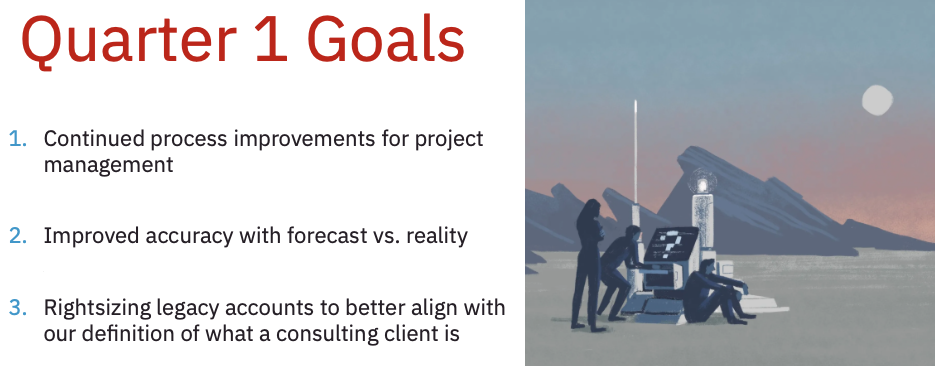
Improving Digital Projects with Retrospectives
Agile has been all the buzz when it comes to managing digital projects. While we take and leave some of the Agile methodology here at Aten, the one concept that can and should be utilized on all projects both large and small is the retrospective. At the most basic level, retrospectives offer the opportunity to reflect on the work completed during a project, surface issues, and suggest improvements. These dedicated and structured conversations allow teams to become more adaptive and better situated to weather issues should a similar one creep up on another project.
Retrospectives run deep in our process at Aten. Traditionally we hold them internally at the end of every sprint during the development phase of our full-service website redesign projects. We also use retrospectives when projects are coming to a close to review how collaboration went during strategy, to design, to development and finally to site launch to inform how we might improve our process with future clients. We also apply the benefits of retrospectives even more broadly to review how a digital consulting engagement has been going with a client or to evaluate the effectiveness of an internal agency initiative. There truly are so many potential applications.
There are loads of resources out there on how to run a retrospective, including our own blog post on the topic. However, there is a real gap for not just project managers, but anyone who manages a digital project, in providing concrete tools and ideas to ensure a retrospective is not just a performative practice where good ideas and insights go to die. So, let’s explore what to do after the retro!
Identify Themes Using Data
Aten recently conducted a remote retrospective with our entire team reflecting on the past year in our digital consulting line of service. We headed off into Zoom breakout rooms armed with FigJam boards and virtual stickies asking three simple prompts:
- What is working?
- What changes would you like to see?
- Now what? Align on three improvements you’d like to make as a group.
This exercise generated nearly 150 suggestions for what’s working and what should change.
After the retro, I knew based on the sheer quantity of ideas that I needed to use that volume to my advantage as a way to bring themes or shared ideas to the surface. Each of those suggestions got assigned a code based on the theme that they fit into. For example, when asked what was working well, “building and maintaining client relationships” was one of the most common responses from my colleagues.
Once all of the ideas were coded, I honed in on the top 3–5 in each theme and allowed those to be the focus of my next steps. While the retro you’re running may not generate 150 ideas, the point is that it likely won’t be productive to focus on every individual point of feedback, but rather to attempt to highlight specific themes that are more prevalent.
Put a Bow on the Outcomes
I’m going to make an assumption that if you’re reading this article you’re probably a busy person who just wants to GSD (get stuff done). If that’s the case, I’d recommend that you also assume the same is true for the folks on your team or in your company.
To that end, make the outcomes of your retro succinct and easily understandable. Don’t send a Google Doc full of 150 bullet points or a multi-paragraph email of insights to interested or affected parties. Don’t create numerous Jira tickets that will likely just keep your backlog warm. Instead focus on 3–5 key takeaways and put those takeaways in a digestible format. Personally I recommend a good ol’ Google Slide deck.
Be absolutely sure in that deck that you’ve highlighted next steps for how you plan to address the main themes that came out of your retro AND who’s responsible for each next step. Does your leadership team need to get involved on a high-level persistent issue? Does your production team need to refine a part of their process? Do you need to convene with a small working group to define action items in a SMART way (more on that below)?
Make Your Action Items SMART
If your retro produced action items and the team is in alignment with them, be specific about the changes you’re hoping to implement. The SMART technique is an oldie but a goodie. SMART stands for Specific, Measurable, Achievable, Realistic, and Time-sensitive. Ensuring your action items are SMART means that you can actually achieve the improvements that you’re setting out to implement.
Take Your Retro on the Road
It’s likely your colleagues gave some of their time and more importantly their valuable ideas and feedback to the retro process. As such, they deserve to know what came out of it.
Now, back to the example I shared earlier. After synthesizing the data from the retro, packaging it into a digestible format, and meeting with a working group dedicated to improving our consulting line of service, I gave an update to the entire company. In that update, I shared a recap of what we learned, what our working group is focusing its energy on, and our next steps.
The timeframe in which you share updates is not as important as your team feeling informed and heard. One of the best ways to ensure your teams feel valued is for them to see change even if it is sometimes slow.
Know When It’s Time to Let Go
Sometimes retros don’t produce a list of actionable ideas or changes to make. Perhaps your project went really, really well (congrats!) and the retro turned out to be more of a celebration of your team’s hard work. Maybe you retro-ed a part of your process that you won’t be repeating in the near future, or your team was just unusually quiet (although that’s never the case at Aten). Regardless, I would use a moment like this to evaluate why the retro may not have been as productive as you hoped. It’s possible that you may need to retro your retro. Try to determine if the format you ran the session in wasn’t a good fit for the team or project. Continuous improvement is the name of the game here, and that applies to the retrospective as well.
Finally, if your retrospective did not produce any actionable ideas or you’ve been unable to act on the ideas presented, it’s OK to let it go. There is so much value in taking the time to get your team together in a single space, whether it’s virtual or in person. So even if you don’t have the resources or interest to take your retro outcomes further, just by having a retro you gave your team an opportunity to connect, collaborate, and even commiserate. Those touch points matter, too.



